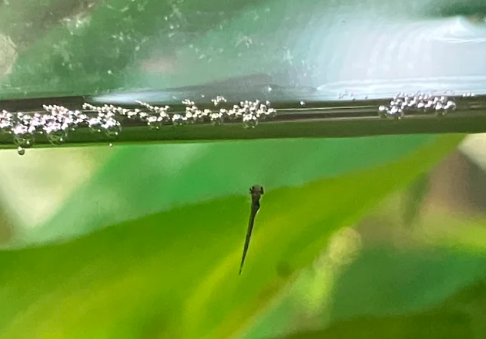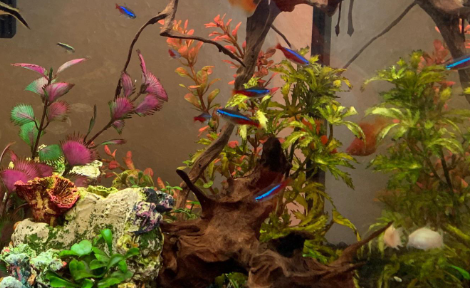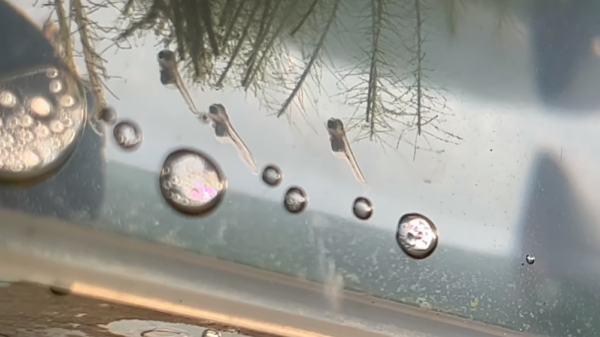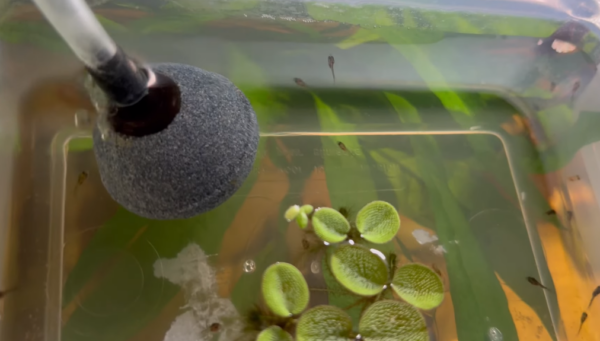When you have your own tropical fish tank, it can be challenging to successfully get your fish to breed and nurse the young fish past those first few crucial weeks. Knowing how to take proper care of tropical fish babies or fry is essential if you want to have thriving young fish.
Yet, with careful preparation and knowledge, you can enjoy a vibrant tank at home with breeding pairs and baby tropical fish.
Table of Contents
How to Correctly Care for Tropical Fish Babies
To care for tropical fish babies, you must create the best water parameters, ensure plenty of hiding spots to protect the young fish from predators (including their own parents), and feed a high-protein meal in the correct quantities to ensure optimal growth.
But let’s learn more about caring for tropical fish babies.
Discover a range of freshwater and tropical fish for your aquarium in our guide.
What Do Tropical Fish Babies Need to Survive?
You may feel overwhelmed when you have a few fish babies hatching in your tropical tank. After all, those new fish babies are so small that it may seem challenging to ensure their safety and feed them so they can grow big and strong.
To make it simple, we encourage people to focus on the basics. Meeting the essential needs of your tropical fish babies can help ensure they survive.
Learn more about how to stop fish from becoming ill with our handy tips.
Here are the five top elements to check before your fish gives birth, and also while tropical fish babies are small and need care.
1. The Water Parameters
Incorrect water parameters are among the first things that can kill your tropical fish babies. Your fish, whether adults or young, need constant water temperatures, the proper water pH and water hardness levels, and a steady chemical composition to the water.
Ensure your breeding pairs have the correct water temperatures for their specific species. Not all tropical fish enjoy the same basic 75℉ to 80℉ temperature waters (using a thermometer is essential). Some prefer warmer temperatures, while others want slightly cooler water temperatures to have their babies in.
It is important to ensure your tropical fish babies have the same constant water temperature as they were hatched or spawned in.
The water pH has to be at the acidity that the species of tropical fish prefer. A pH of 5-8 is usually the spectrum for tropical fish, but again, one species will thrive in a 5 pH water, while the other will only survive. Know your tropical fish breed requirements.
Finally, the water hardness is also an important consideration. Some tropical fish prefer softer water, while others enjoy harder water types. The average is 4 to 12 dKH, but the ideal water hardness will ensure your tropical fish babies have healthy skin and fins and develop according to their breed standards.
The most important thing with the water parameters is maintaining the same temperature, pH, and water hardness (which should be the optimal range for your tropical fish species) to prevent your fish babies from becoming stressed and not growing well.
Also Read: Breeding Livebearing Fish
2. Water Filtration Requirements
When you keep fish, they make a lot of waste. Urine, fish poop, and leftover fish food can all add to the water content, causing disease and making your baby fish sick. The fish tank must have a filter system to keep the water healthy and remove waste.
A serious consideration with a tank that has small fish or fry is that the filter has to be fitted with a sponge cover to prevent the filter from sucking up your tropical fish babies. A too-powerful filter that blasts water from the outlet into the tank will also damage delicate young fish.
For this reason, fry are often separated into a smaller floating tank chamber where they are protected from the strong current and being sucked up into the filter.
Another aspect of water quality and filtration is the weekly water changes. While you may have gotten away with adding new water to your tank that’s a few degrees colder than your tropical fish adults prefer, your fry will quickly have an adverse reaction and die. So ensure you add heated water (at the correct temperature) when doing a water change.
The weekly water changes are vital to ensure your fry has a steady supply of fresh water and dilute the effect of any potentially harmful contaminants in the tank. A good rule is to change out 15-20% of the water with fresh, filtered water.
3. Good Hiding Spots from Predators and Adult Fish
The main cause of death in young fry is being eaten by other fish. Most fish are opportunistic feeders and will happily gobble up a tasty, protein-rich fry. Even their own offspring are considered fair game by many fish species.
For this reason, fish babies instinctively hide among porous rocks, reefs, aquatic plants, and other larger substrate elements. A tank with no hiding spots will soon be without fish babies.
Consider adding some tropical fish-friendly plants like java moss, which offer many excellent hiding spots for young fish.
If you have no hiding spots in your tank or don’t want to lose any tropical fish babies to predation, the best bet is to move the pregnant female to a breeding tank or chamber a few days before she gives birth or lays eggs. Once the young are born, you can gently scoop the mom back into the main tank and then ensure you provide enough food to the young fry.
Some fish species have exceptional parental care; in this case, the male or female fish will care for their young. So you don’t want to remove them from the tank as the baby fish need their parents to help them grow.
Also Read: Badis Badis: Full Care Guide, Breeding, Tank Size & Diseases
4. Feeding Requirements for Young Tropical Fish
When tropical fish eat well, they grow fast and reach their full potential. Young, growing fish need a balanced diet, and while your instinct may be to feed protein-rich meals, other nutrients are also vital.
Consider getting the best possible tropical fish food appropriate for fry and young fish. These foods are loaded with vitamins for healthy immune development, calcium for bone and scale growth, and protein for energy to grow steadily.
Never overfeed tropical fish babies, but feed regular meals (usually three to four meals per day) at the same intervals. So, if you feed your fry at 6 a.m., 10 a.m., 1 p.m., and 6 p.m., you should stick to the exact feeding times each day to ensure a steady food intake with some time to digest properly.
Never feed your fish more than they can eat in a few minutes to prevent bloating and stop excess food from rotting and contaminating the water.
5. Medical Needs of Tropical Fish Fry
While you hope your fry will be healthy and quickly grow up to be beautiful tropical fish like their parents, there is often the chance that they may become sick, get infected with contagious diseases, and die.
To prevent illness and ensure they thrive, you may need to keep a few medications on hand to administer as soon as you notice any signs of disease.
Look for signs like fins rotting, white fluff forming on their scales, bloody growths around their mouths and eyes, weight loss, or misshapen bodies. When your fry becomes dull and doesn’t look energetic, it could also be an early warning sign that something is amiss.
Not all fish diseases are easily treated, so your best cure is to prevent infection. Ensure your fish have ideal water parameters and that the water is well-filtered to remove decaying organic material, which could cause bacteria to breed.
If you add new fish to your tank, first quarantine them to ensure no unwanted parasites like lice, worms, and fungi are present on them. Likewise, quarantine your new aquatic plants, too, as these can also transfer contaminated materials to your tank.
When needed, you can use medication to treat fungal infections and ich. Some medications may prove too harmful for new fry, so avoiding problems before they start is much better.
Preparing to Care for Your Tropical Fish Fry
Your breeding pair has surprised you with a hatching of eggs, or new babies have just spawned, and you suddenly have to take measures to ensure the fry will survive and thrive.
How do you prepare to care for your tropical fish fry? Here are a few steps to take:
- Determine the species of eggs or fry. This will help you decide whether to remove the offspring from the tank or if the parents need to be isolated along with the fish.
- Test your water parameters to ensure these are at optimal levels. If you have the facilities near you, it’s worth having a water sample tested at a professional lab, which will tell you exactly how much nitrates, organic matter, and potential contaminants your tank water currently has.
- Isolate the young fish from the rest of the tank’s occupants. If you have a dense underwater planted tank, you’ll find the fry will survive fairly well. However, if you have limited plants or your fish are relatively expensive, you may not want to risk them getting eaten – which is the number one cause of death in young fish.
If you can’t remove them from the tank, cordon off a section with acrylic dividers or install a breeding tank inside the main tank.
- Create a daily record of when you feed the fry, what time, how much food, and any changes you notice. Observe the fry during feeding time to ensure all fish eat and have equal opportunity to get to food. Smaller or weaker fry may not always get to eat, so you may need to feed them individually until the more vulnerable fish get stronger.
Learn more African Leaf Fish
Dangers to Your Tropical Fish Fry and Solutions
Knowing the main dangers to your tropical fish fry is how you can head off disaster and ensure your baby fish reaches adulthood.
Here are some common dangers to watch out for, as well as solutions to help you cover all bases:
Sucked into the Filter
Fry are small and not very strong swimmers yet, so they can easily get sucked into the filter or get washed away by the water return, which leads to shredded fins, hitting obstacles, and injury.
Solution: Change the filter to a sponge filter or add an intake sponge to cover the filter intake. You can also add a filter bag over the filter to prevent fish from being sucked up.
Eaten by Larger Fish
Adult fish will often eat anything, including small fry. Even the fry’s own parents may gobble them up as they hatch or spawn.
Solution: Add a section of coral reef, driftwood, or soft water plants to provide hiding spots for the fry. Take care not to feed the adults near the fry at feeding time.
Regular Feeding Schedule
Fry need a constant supply of nutrients, which should be evenly spread throughout their day. When you miss a feeding session, the fry may panic and become stressed, leading to weakened immunity and death.
Solution: Use an automated feeder to ensure regular feeding sessions if you can’t be home daily at feeding time.
Illness and Disease
Tropical fish are sensitive to water parameters, so if the tank temperature, pH, water hardness, or clarity has a significant variance, the fry will become stressed, which affects their digestion and immunity. They are more susceptible to infections, fungi, and parasites.
Solution: Ensure optimal water parameters are maintained by using an automated thermometer, regularly testing the tank pH and water hardness, and ensuring adequate filtration.
FAQs
A natural protein-rich food, like live baby brine shrimp, is ideal for raising tropical fish fry. The shrimp are small enough to be eaten by the baby fish and are live food, which helps the fish discover how to hunt their prey. Other great food options include infusoria, green algae disks, and finely ground fish flakes.
Regular, small meals are the best option for tropical baby fish. When in doubt, add another meal, but never increase the meal size to more than the fry can eat in a few minutes. Use an automatic feeder if you can’t get home to feed your fry every few hours.
If you remove your fry from the tank, it’s advisable to keep them isolated from the adults until the fry aren’t smaller than the adult fish’s mouths. On average, this takes 4 to 6 weeks.
Final Fish Fry Rearing Thoughts
Knowing how to properly care for tropical fish babies is vital to a successful breeding program. But even if you let nature take its course, watching the adult fish gobble up the small fry is still upsetting. Therefore, knowing how to ensure the baby tropical fish are safe, fed, and thriving is important for the hobbyist aquarist.
Have you had tropical fish babies in your tank? How did you take care of them, and what dangers did you face in your tank’s setup? Let us know in the comments section.
Learn how to create a planted carpet for your fry to hide in with our handy guide.




